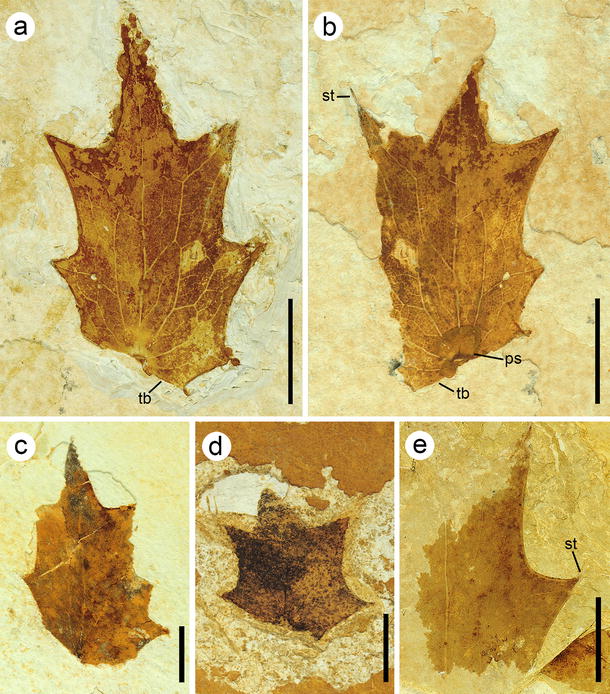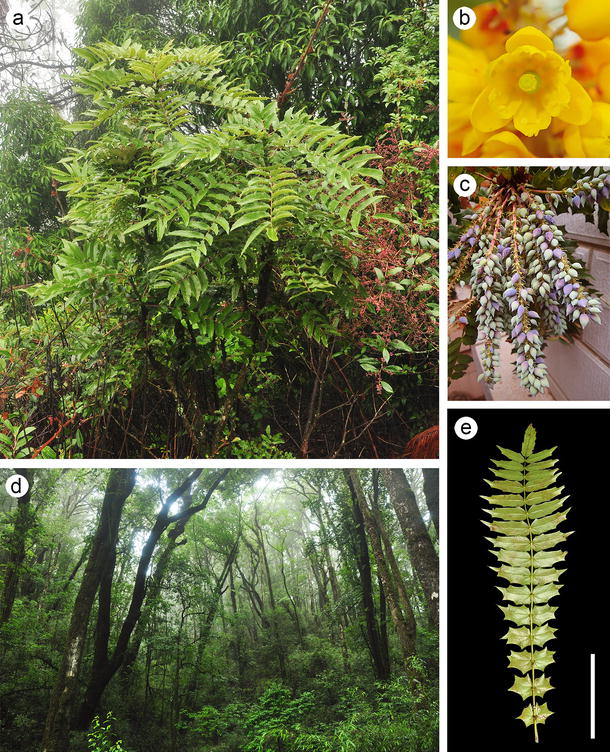The genus Mahonia is a member of the basal eudicots, a group with many taxa with East Asia-North America disjunct distributions. They are shrubs or small trees with evergreen, coriaceous (sclerophyllous), compound leaves. Mahonia species can easily be recognized by the distinctive architecture of their imparipinnately compound leaves and spiny leaflets. However, until now, no reliable fossil records of Mahonia had been identified from East Asia. The lack of Asian fossils has limited the interpretation of the biogeography of this genus.
Prof. ZHOU Zhekun and his team of Xishuangbanna Tropical Botanical Garden (XTBG) recently found fossils of Mahonia leaflets from the Upper Miocene of Wenshan, Yunnan, southwestern China. They compared the fossil leaves to extant species of Mahonia. The specimens represented the oldest reliable fossil record of Mahonia in East Asia. The researchers regarded it as a new fossil species and named it as Mahonia mioasiatica J. Huang et Z. K. Zhou sp. nov. .The new fossil species showed a general similarity to Group Orientales and was most similar to the extant eastern Asian Mahonia conferta.
The researchers furthermore discussed the biogeographical implications of the newly found fossil species. They hypothesized that migration of the genus between North America and eastern Asia would likely have taken place over the North Atlantic Land Bridge rather than the Bering Land Bridge or long distance dispersal. The results showed that over geologic time the geographic area with the highest Mahonia species diversity shifted from western North America to Europe and then to southwestern East Asia. Species in Group Orientales are the most widely dispersed lineage, possibly owing to their adaption to forest environments.
The finding of the oldest fossil of Mahonia shed new lights on the East Asian-North American disjunct distribution.
The study entitled “The oldest Mahonia (Berberidaceae) fossil from East Asia and its biogeographic implications” has been published online in Journal of Plant Research.
Contact
ZHOU Zhekun, Ph.D Principal Investigator
Key Laboratory of Tropical Forest Ecology, Xishuangbanna Tropical Botanical Garden, Chinese Academy of Sciences, Mengla, Yunnan 666303, China
Tel: 86-871-65109223
E-mail: zhouzk@xtbg.ac.cn

Mahonia mioasiatica J. Huang et Z. K. Zhou sp. nov. from Wenshan, Yunnan, China.
a M. mioasiatica (DMS-0383A)(Holotype) leaflet with obliquely truncate(tb).
b DMS-0383B (Counterpart of DMS-0383A) tb truncate base, ps palmate secondary venation (indicate by grey color lines), st spinose tooth.
c DMS-1279. d DMS-1281, probably a basal leaflet. e DMS-0386 st spinose tooth.
(Image by HUANG Jian)

Extant Mahonia, their habitat and biology.
a M. duclouxiana tree in the forest window in Mt. Ailaoshan, Yunnan, China, individuals of this community are dwarf shrubs when under the shady forest.
b Flower of M. duclouxiana, the trimerous perianth indicate its basal position in the angiosperm phylogeny tree.
c Purplecolored berries of M. conferta.
d Mid-Montane Humid Evergreen Broad-Leaved Forest in Mt. Ailaoshan, Yunnan.
e Leaflets variation in M. conferta, leaflets increasing in length but decreasing in width from base to apex, and, shift from short with coarse tooth to long with drip-tip.
(Image by HUANG Jian)


